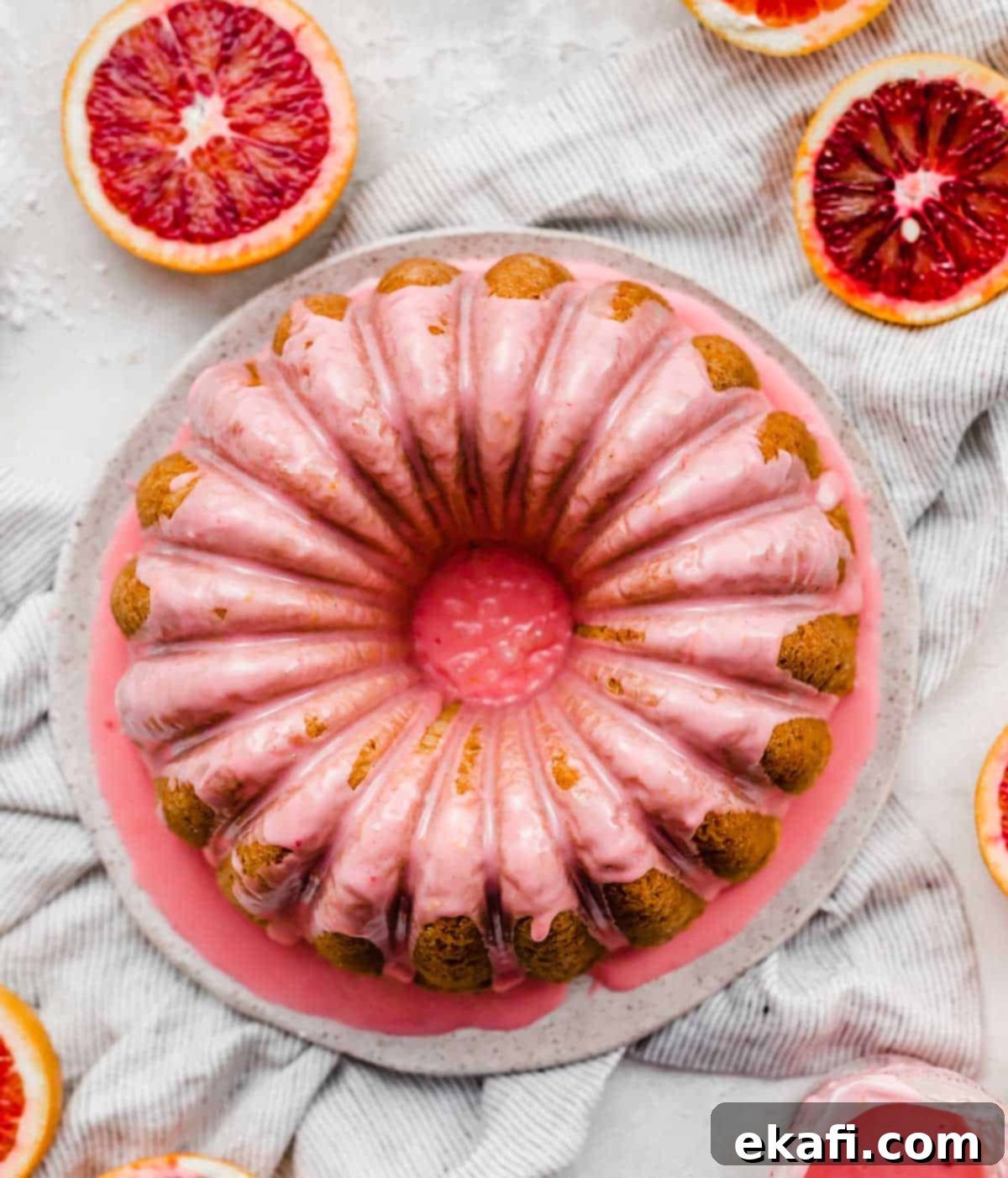Moist Blood Orange Cardamom Bundt Cake with Zesty Glaze: The Ultimate Recipe
Prepare to be absolutely enchanted by this spectacular Blood Orange Cardamom Bundt Cake. It’s a true celebration of vibrant flavors and delightful textures, perfect for elevating any occasion. Each slice reveals a supremely moist and tender crumb, infused with the bright, citrusy essence of blood oranges, beautifully complemented by soft, aromatic hints of cardamom. Topped with a luscious, thick, and brilliantly hued blood orange glaze, this cake isn’t just a dessert – it’s an experience. Get ready to elevate your brunch spread or dessert table to an unforgettable level!
Beyond this incredible bundt cake, don’t let any leftover blood oranges go to waste! Their unique flavor can shine in other delicious creations. Consider making my delightful Blood Orange Chia Pudding for a healthy, zesty treat, or incorporate them into my easy and irresistible Orange Rolls for a citrusy twist on a classic comfort food.
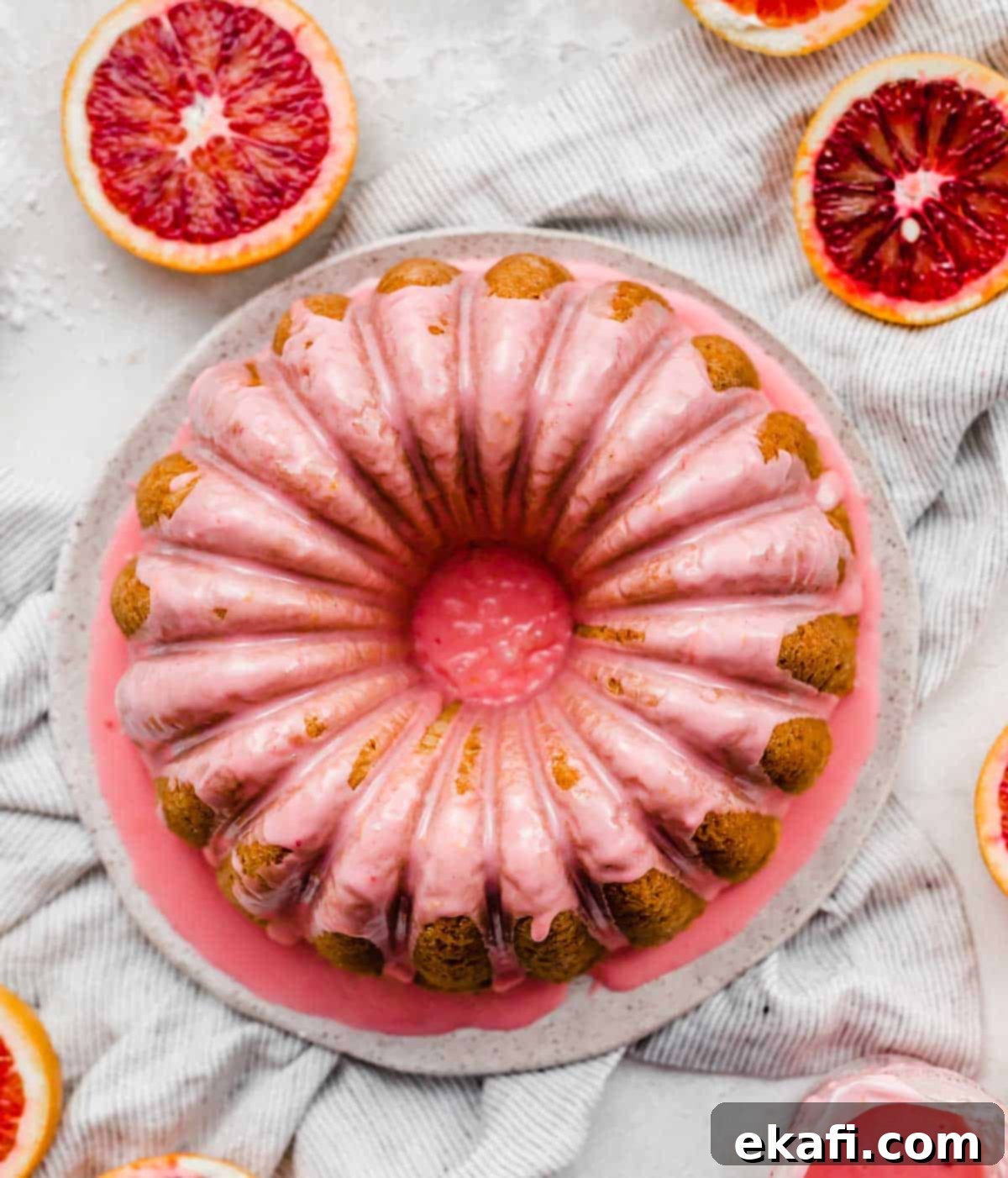
Why This Blood Orange Bundt Cake Recipe is a Must-Try
This isn’t just another cake recipe; it’s a meticulously crafted culinary delight designed to impress. Here’s why this Blood Orange Cardamom Bundt Cake will quickly become a cherished favorite in your recipe collection:
- A Stunning Centerpiece for Any Occasion: This blood orange bundt cake is more than just a dessert; it’s a showstopper. Its elegant bundt shape, combined with the striking pink glaze derived from the natural juices of blood oranges, makes it visually stunning. It’s the perfect cake to serve when you want to make a lasting impression at dinner parties, celebratory brunches, Sunday family dinners, Easter gatherings, or any special dessert night. Its sophisticated appearance and unique flavor profile will have your guests asking for the recipe.
- Exquisite Flavor with a Golden Crumb and Vibrant Glaze: Not only does this orange cardamom cake boast a perfect golden crumb that is irresistibly soft and moist, but the natural pigments from the blood oranges also create a beautifully vibrant pink glaze. This isn’t just about aesthetics; the glaze offers a zesty, tangy punch that perfectly balances the subtle sweetness and aromatic warmth of the cardamom-infused cake. The combination of bright citrus and warm spices creates a harmonious flavor that is both comforting and exciting, truly evoking the fresh, bright feelings of springtime.
- An Unforgettable Taste Experience: Each bite of this blood orange cardamom cake is a journey for your taste buds. The initial burst of sweet and tangy blood orange is quickly followed by the delicate, floral, and slightly spicy notes of cardamom. A hint of cinnamon rounds out the profile, adding a cozy warmth that makes the flavors sing. This complex yet balanced blend ensures that every mouthful is a delight, leaving a memorable impression long after the last crumb is savored. It’s a truly delicious flavor combination that will elevate your baking game.
Essential Ingredients for Your Blood Orange Bundt Cake
Crafting the perfect Blood Orange Cardamom Bundt Cake starts with understanding the role of each ingredient. Here’s a detailed look at what you’ll need and why it matters:
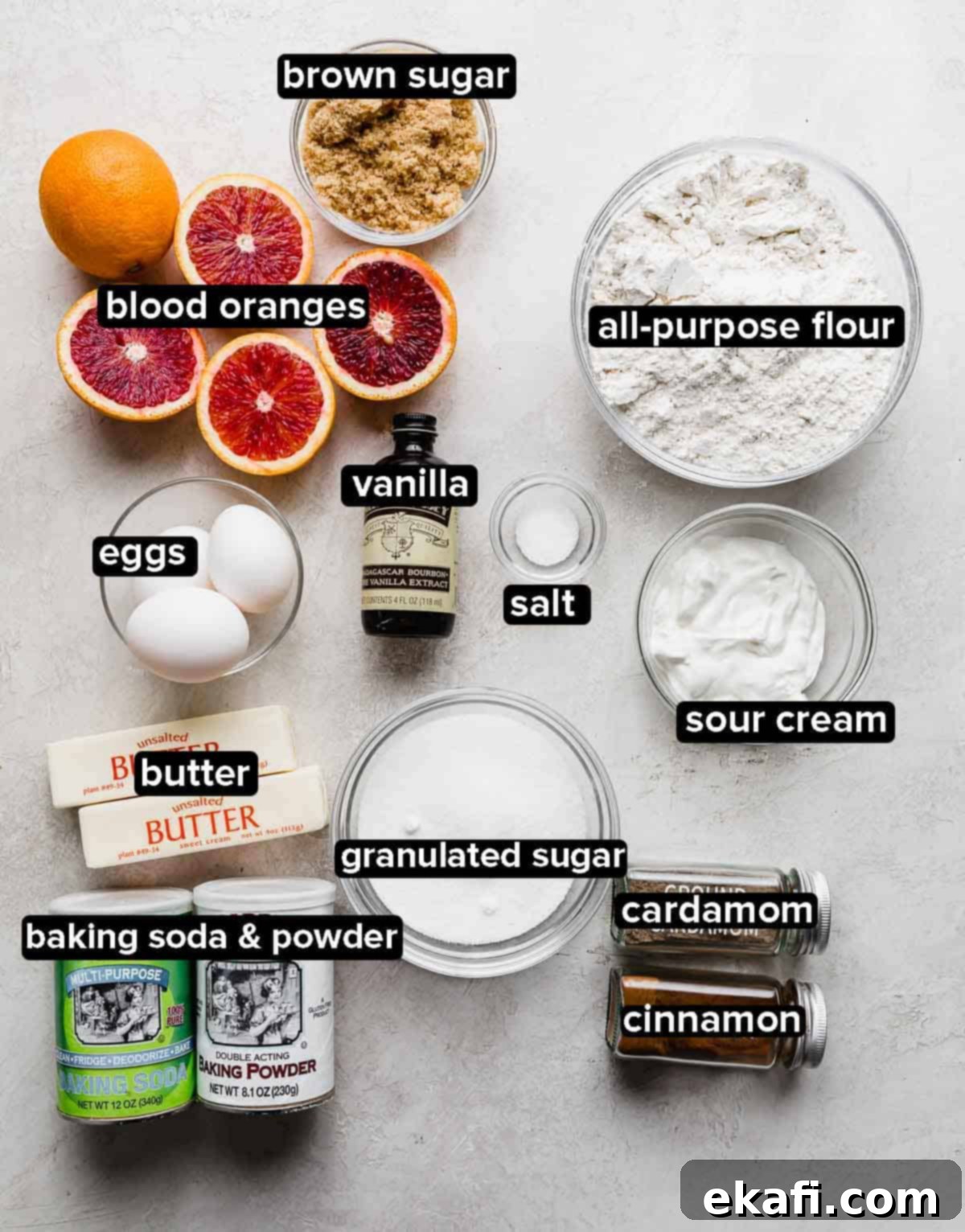
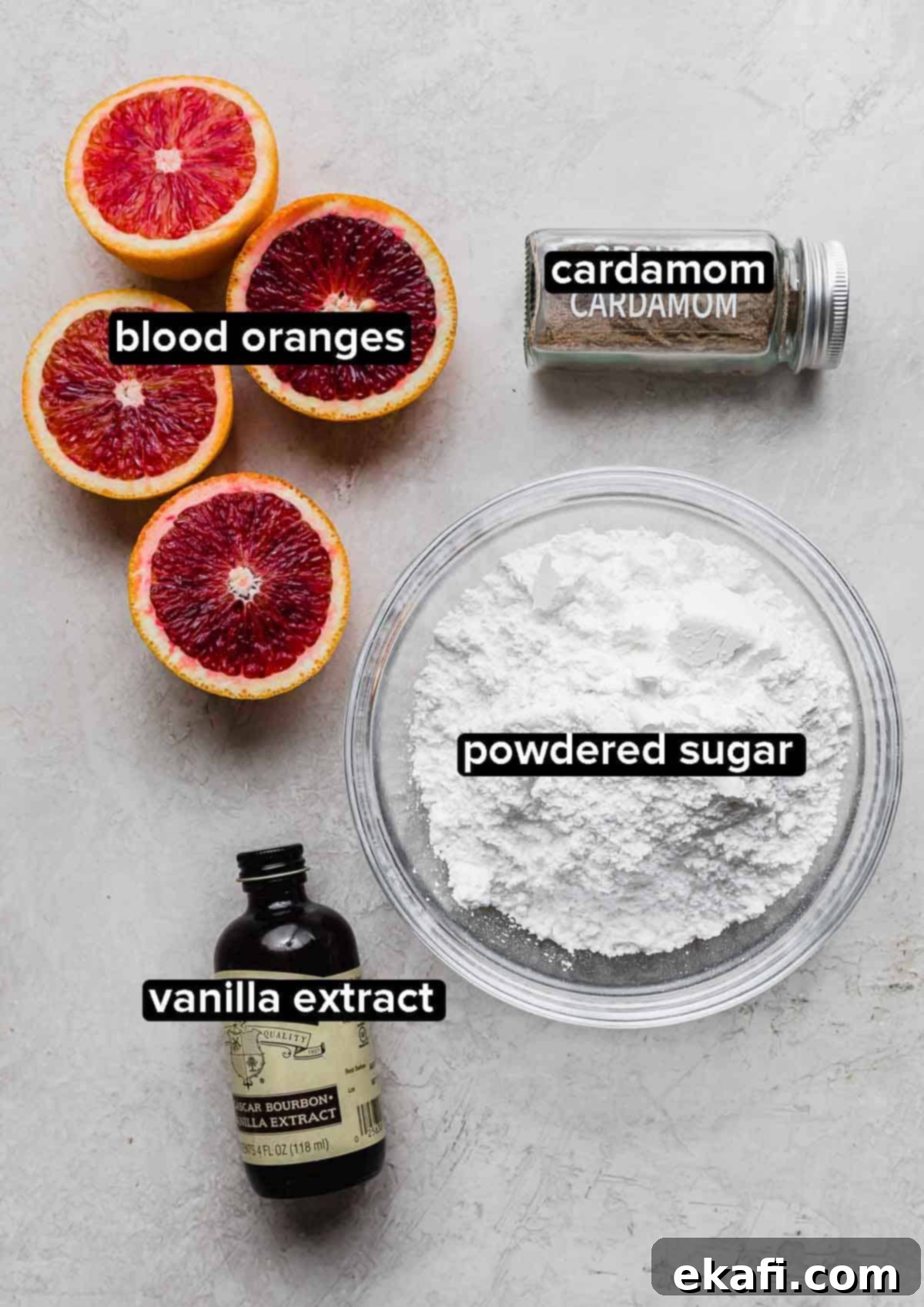
- All-Purpose Flour: The foundation of our cake, providing structure. For the lightest, most tender crumb, ensure your flour is fresh and consider sifting it with the other dry ingredients. This helps remove any lumps and incorporates air, resulting in a finer texture.
- Baking Powder & Baking Soda: These are our leavening agents, responsible for the cake’s light and fluffy texture. This recipe was perfected at sea level. If you live at a higher altitude, remember that leavening agents react differently. King Arthur Baking offers an excellent guide with suggested substitutions and adjustments for high-altitude baking.
- Cardamom: This unique spice is key to the cake’s distinctive aroma and flavor. I recommend starting with 1/2 teaspoon for a subtle, fragrant whisper that becomes more pronounced towards the end of each bite. If you’re a cardamom enthusiast and desire a bolder, more prominent flavor, don’t hesitate to increase it to 3/4 teaspoon. Its floral, slightly citrusy, and warm notes pair exquisitely with blood orange.
- Cinnamon: A touch of cinnamon works wonders to complement the cardamom, adding a comforting warmth and a familiar balance to the overall spice profile. It deepens the flavor without overpowering the star citrus.
- Unsalted Butter: Using unsalted butter gives you precise control over the salt content in your baking. Ensure it’s softened to room temperature, which is crucial for proper creaming with the sugars, creating an aerated base that contributes to the cake’s light texture. If salted butter is all you have, simply reduce the added salt in the recipe by about 1/4 teaspoon.
- Granulated Sugar & Brown Sugar: The combination of these two sugars plays a vital role. Granulated sugar provides sweetness and contributes to the cake’s structure and golden crust. Brown sugar, with its molasses content, is instrumental in retaining more moisture, ensuring our blood orange cardamom bundt cake is incredibly tender and moist.
- Blood Orange Zest & Juice: These are the heart of our blood orange flavor! The zest contains concentrated essential oils that deliver intense citrus aroma and flavor without adding extra liquid. I typically use 3 tablespoons of zest, but for an even more pronounced “orange-y” flavor, feel free to add an extra tablespoon. The fresh blood orange juice adds tanginess and moisture to both the cake and its vibrant pink glaze.
- Large Eggs: It’s best to use large eggs at room temperature. Room temperature eggs emulsify better with the butter and sugar, creating a smoother batter and a more uniform, tender cake texture. They also add richness and act as a binder for the cake.
- Vanilla Extract: A classic flavor enhancer, vanilla extract adds a layer of warmth and complexity that beautifully rounds out the citrus and spice notes in the cake. Use a good quality pure vanilla extract for the best results.
- Full-Fat Sour Cream: This secret ingredient is a game-changer for cake texture. Using full-fat sour cream adds significant moisture and rich creaminess to the batter. Its acidity reacts with the baking soda, contributing to a wonderfully light, fluffy, and tender crumb that stays moist for days.
Effortless Step-by-Step Instructions for Your Blood Orange Bundt Cake
Creating this stunning Blood Orange Cardamom Bundt Cake is simpler than you might think. Follow these clear, detailed steps for a perfect bake every time:
- Prepare Your Pan and Oven: Preheat your oven to 350ºF (175°C) and ensure the oven rack is in the center position. This promotes even baking. Next, prepare a 10-cup bundt pan. Thoroughly grease and flour the pan, ensuring every crevice is coated. A baking spray with flour (like Baker’s Joy) is also an excellent option for easy release. Set the prepared pan aside.
- Combine Dry Ingredients: In a medium-sized mixing bowl, whisk together 3 cups of all-purpose flour, 3 teaspoons of baking powder, 3/4 teaspoon of baking soda, 1/2 teaspoon of ground cardamom, 1/4 teaspoon of cinnamon, and 1/2 teaspoon of salt. Whisk well until all ingredients are thoroughly combined and no lumps remain. This ensures even distribution of leavening and spices. Set this dry mixture aside.
- Cream Wet Ingredients: In the bowl of a stand mixer fitted with the paddle attachment (or using a large bowl with a hand mixer), combine 1 cup of softened unsalted butter, 1 cup of granulated sugar, and 1/2 cup of packed brown sugar. Beat on medium speed for 2-3 minutes until the mixture is light in color and fluffy in texture. This step incorporates air, vital for a tender cake. Add the 3 large room-temperature eggs, one at a time, beating well after each addition until fully incorporated. Remember to scrape down the sides of the bowl as needed. Finally, mix in 3 tablespoons of blood orange zest, 1/4 cup of fresh blood orange juice, and 1 teaspoon of vanilla extract until just combined.
- Alternate Flour Mixture and Sour Cream: With the mixer on low speed, begin alternating additions of your dry flour mixture and the 1 cup of full-fat sour cream to the wet ingredients. Start and finish with the flour mixture. This means the sequence should be: flour, sour cream, flour, sour cream, and finally, flour. Mix each addition only until *just* barely combined. Be careful not to overmix the batter, as this can lead to a tough cake.
- Pour into Pan and Bake: Gently pour the prepared cake batter evenly into your thoroughly greased and floured 10-cup bundt pan. Place the pan in the preheated oven and bake for 45-50 minutes. The cake is done when a wooden skewer or toothpick inserted into the center comes out with a few moist crumbs attached, but not wet batter. My cake typically bakes perfectly at 47 minutes.
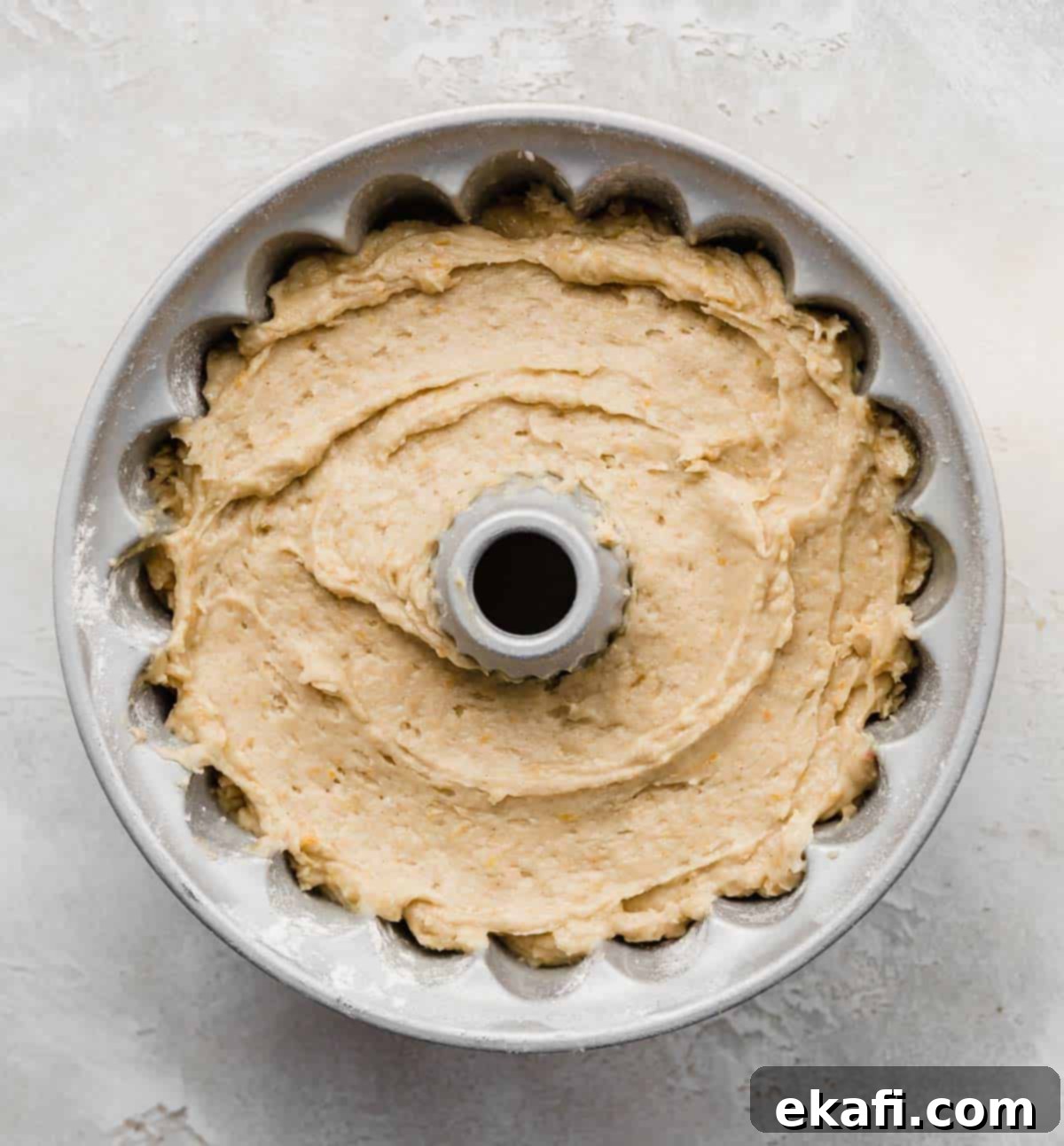
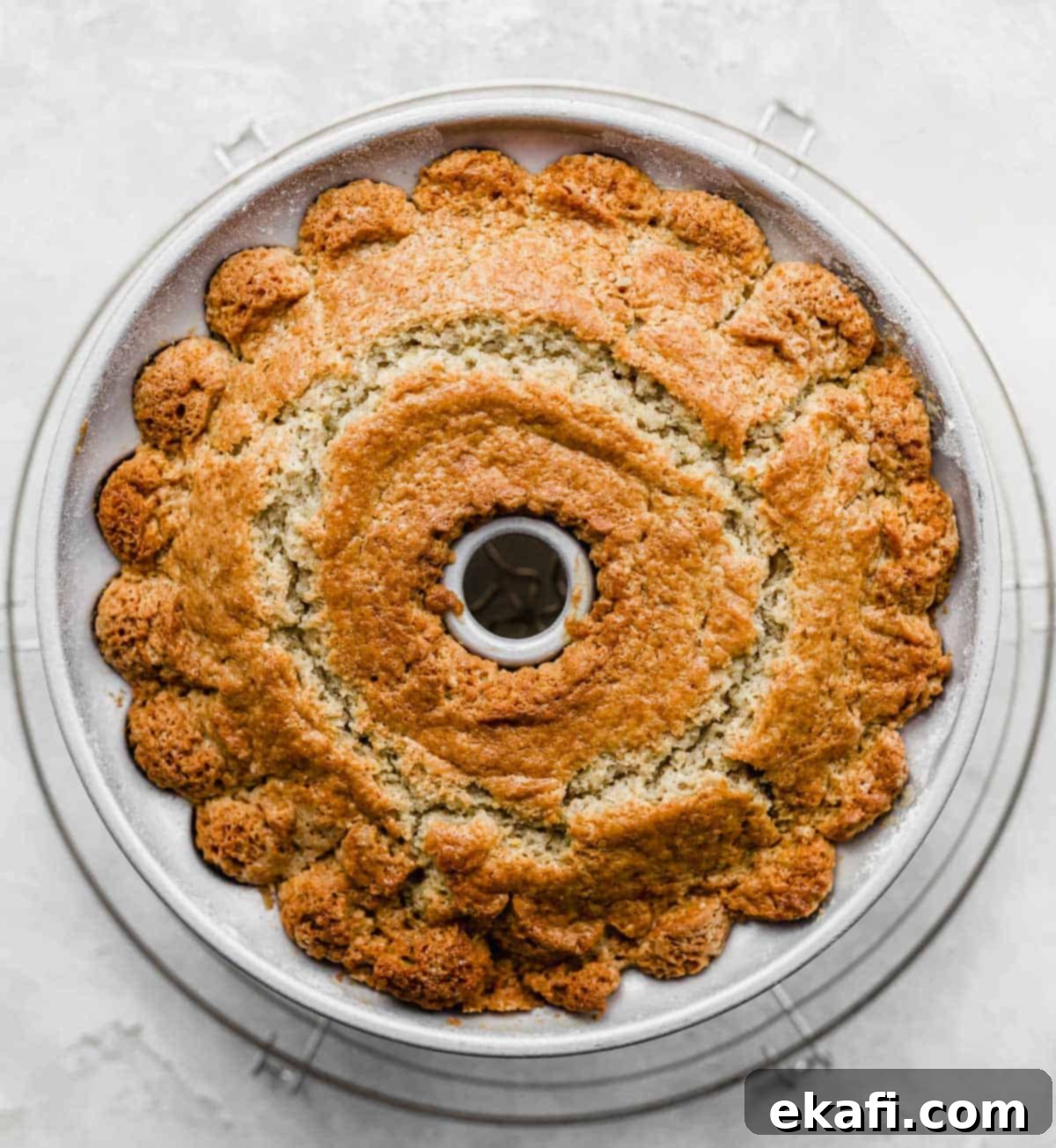
- Cool the Cake: Once baked, remove the cake from the oven and let it cool in the bundt pan on a wire rack for exactly 10 minutes. This crucial cooling period allows the cake to set and firm up, making it easier to unmold. After 10 minutes, carefully invert the pan onto the wire rack to fully release the cake. Allow the cake to cool completely on the wire rack until it is just slightly warm to the touch before glazing.
- Prepare the Blood Orange Glaze: While the cake is cooling, prepare the stunning glaze. In a liquid measuring cup or a small bowl, combine 1/3 cup of fresh blood orange juice, 1/2 teaspoon of vanilla extract, and a small pinch of ground cardamom. Gradually whisk in 2 1/2 cups of powdered sugar until the mixture is completely smooth and free of lumps. The desired consistency should be pourable, but still thick enough to coat the back of a spoon. If it’s too thick, add a tiny bit more blood orange juice (1 teaspoon at a time). If it’s too thin, whisk in more powdered sugar (1 tablespoon at a time).
- Glaze and Serve: Once your cardamom bundt cake has cooled completely (or is just slightly warm to the touch for a slightly thinner glaze that soaks in a bit), it’s time for the grand finale! Place the wire rack with the cake over a baking sheet or parchment paper to catch any drips. Slowly and evenly pour the bright pink blood orange glaze over the top of the cake, allowing it to cascade down the sides. Let the glaze set for about 15-20 minutes before slicing and serving this magnificent treat!
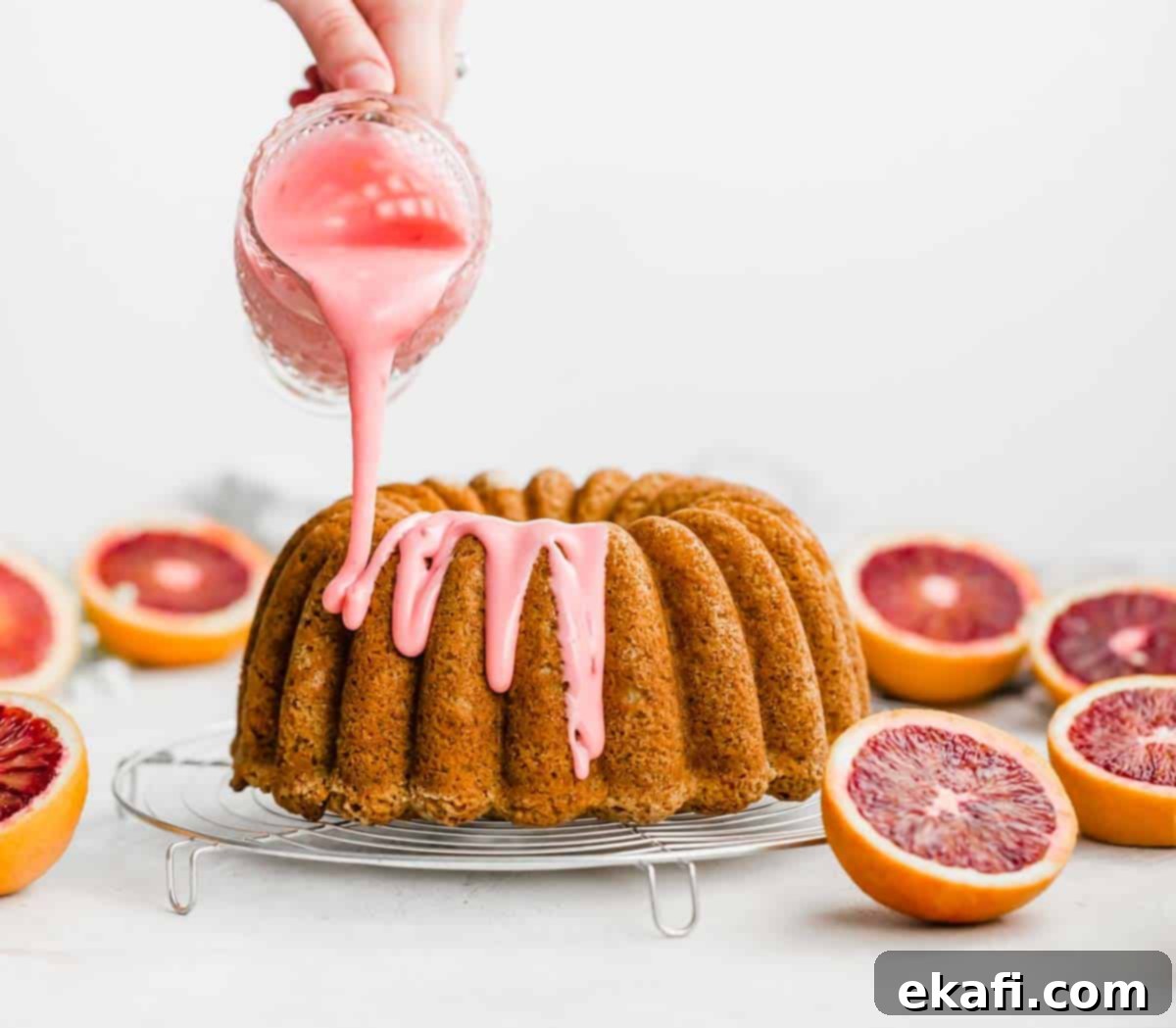
Expert Tips for a Perfect Blood Orange Bundt Cake Every Time
Achieving bundt cake perfection requires a few tried-and-true techniques. Here are my top tips to ensure your Blood Orange Cardamom Bundt Cake turns out beautifully moist, flavorful, and releases flawlessly from the pan:
- Lock in Moisture with Plastic Wrap: Once your cake has cooled enough that it’s just warm to the touch (but not hot enough to create condensation), cover it immediately with plastic wrap. This simple trick traps residual steam and moisture within the cake, preventing it from drying out and keeping it wonderfully soft and fresh for longer.
- Mastering the Glaze Consistency: The perfect blood orange glaze should be pourable yet thick enough to beautifully coat the cake and gently drip down the sides without being too watery. If your glaze seems too runny, gradually whisk in more powdered sugar, one tablespoon at a time, until you reach the desired thickness. Conversely, if it’s too thick to pour smoothly, add a tiny splash (1/2 teaspoon increments) of extra blood orange juice until it reaches the ideal consistency.
- Choose Your Bundt Pan Wisely: When selecting a bundt pan, especially if you’re new to bundt baking, I recommend starting with a pan that has a simpler design. Intricate patterns, while beautiful, can be notoriously challenging to unmold cleanly. A less detailed pan will make the release process much easier and reduce the risk of frustrating stuck bits.
- The Golden Rule of Greasing and Flourishing: This is arguably the most critical step for any bundt cake! You must grease and flour your bundt pan exceptionally well. Use a pastry brush to spread softened butter or shortening into *every single crevice* of the pan. Then, generously dust with flour, tapping the pan to ensure the flour adheres everywhere, and shaking out any excess. For an extra layer of insurance, I often use a baking spray that contains flour (like Baker’s Joy or Pam Baking Spray) after greasing. This double-layer method creates a non-stick barrier that guarantees your cake will slide out effortlessly.
- Patience is Key for Cooling: After baking, resist the urge to immediately flip your cake out of the pan. Allow the bundt cake to cool in its pan for at least 10-15 minutes on a wire rack. This allows the cake’s structure to set, preventing it from collapsing or breaking when you unmold it. Once inverted, let the cake cool *completely* on the wire rack before applying the glaze. Glazing a warm cake will cause the glaze to melt and soak in too much, rather than forming that beautiful, defined coating.
- Select the Best Blood Oranges: For the most vibrant color and flavor, choose blood oranges that feel heavy for their size, indicating juiciness. They should have firm, smooth skins, and a rich, deep red blush, though the exterior color can vary depending on the variety.
Make Ahead, Storing, and Freezing Your Bundt Cake
This Blood Orange Cardamom Bundt Cake is not only delicious freshly baked but also holds up wonderfully for future enjoyment. Here’s how to properly make it ahead, store it, and even freeze it:
- Storing the Cake: To maintain its moistness and prevent it from drying out, always cover the cake tightly with plastic wrap or store it in an airtight cake dome. It can be stored at room temperature for up to 3 days. While delicious throughout this period, the cake is generally at its absolute best when served within the first 2 days.
- Freezing a Whole Cake (with glaze): If you plan to freeze the cake with its glaze, first allow the cake to cool completely, and then apply the glaze. Once the glaze is set, flash freeze the entire cake on a baking sheet for about an hour until the glaze is firm. Then, double-wrap the glazed blood orange cardamom cake securely in plastic wrap. For freezing longer than 1 week, add an additional layer of aluminum foil to prevent freezer burn. It can be frozen for up to 3 months. To serve, remove it from the freezer and let it thaw in the refrigerator overnight, then bring it to room temperature before serving.
- Freezing a Whole Cake (without glaze): For optimal freshness and texture, it’s often preferable to freeze the cake *without* the glaze. Bake and cool the cake completely, then double-wrap it in plastic wrap and a layer of aluminum foil. Freeze for up to 3 months. The day you plan to serve it, thaw the cake overnight in the refrigerator, bring it to room temperature, and then prepare and apply the fresh blood orange glaze. This ensures the glaze is vibrant and perfectly set.
- Freezing Individual Slices: For convenient individual portions, slice the cooled cake (preferably unglazed) and wrap each slice tightly in plastic wrap. Place the wrapped slices in an airtight freezer-safe container or freezer bag. Remove individual slices as needed and let them thaw in the refrigerator for a few hours or at room temperature until soft.
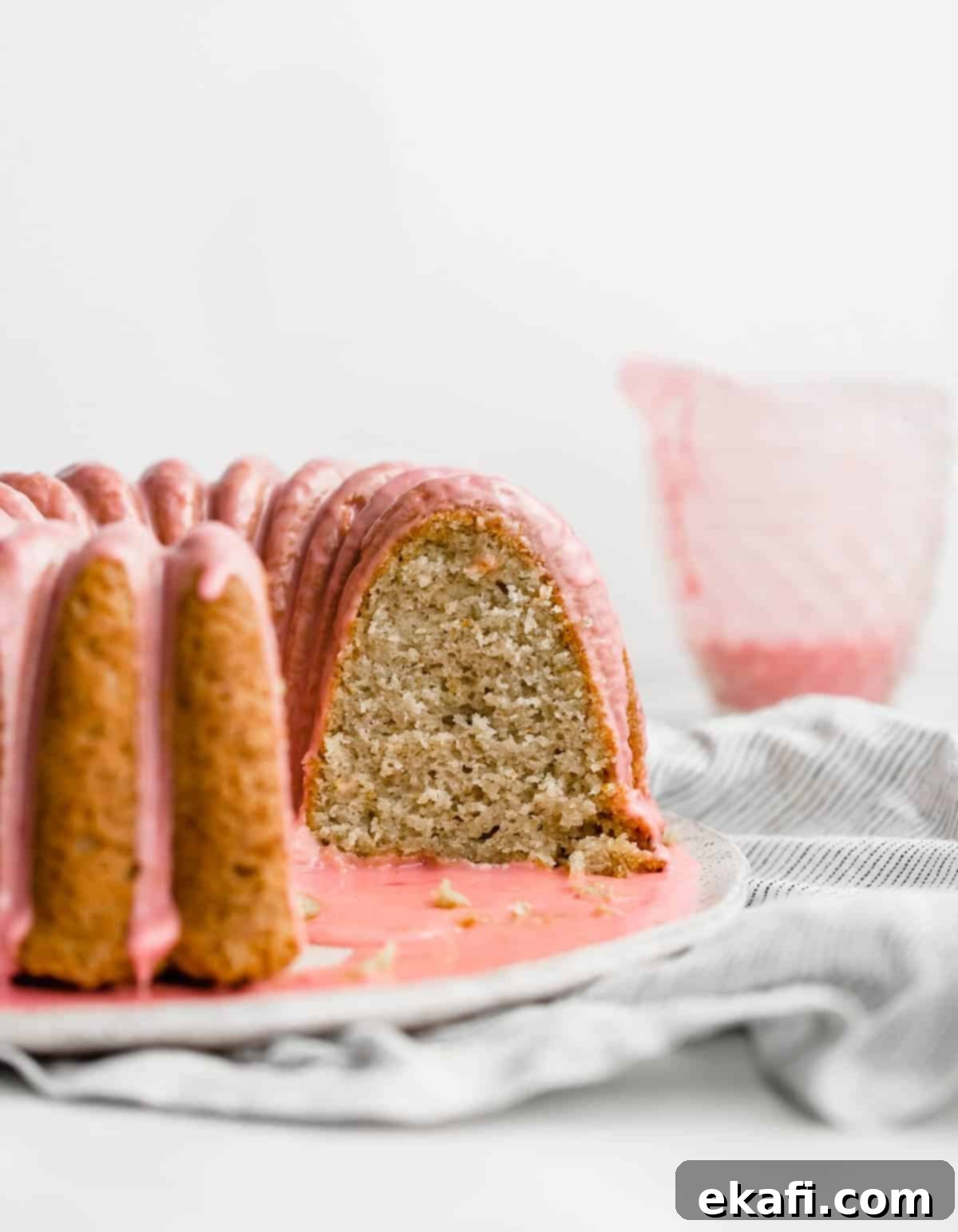
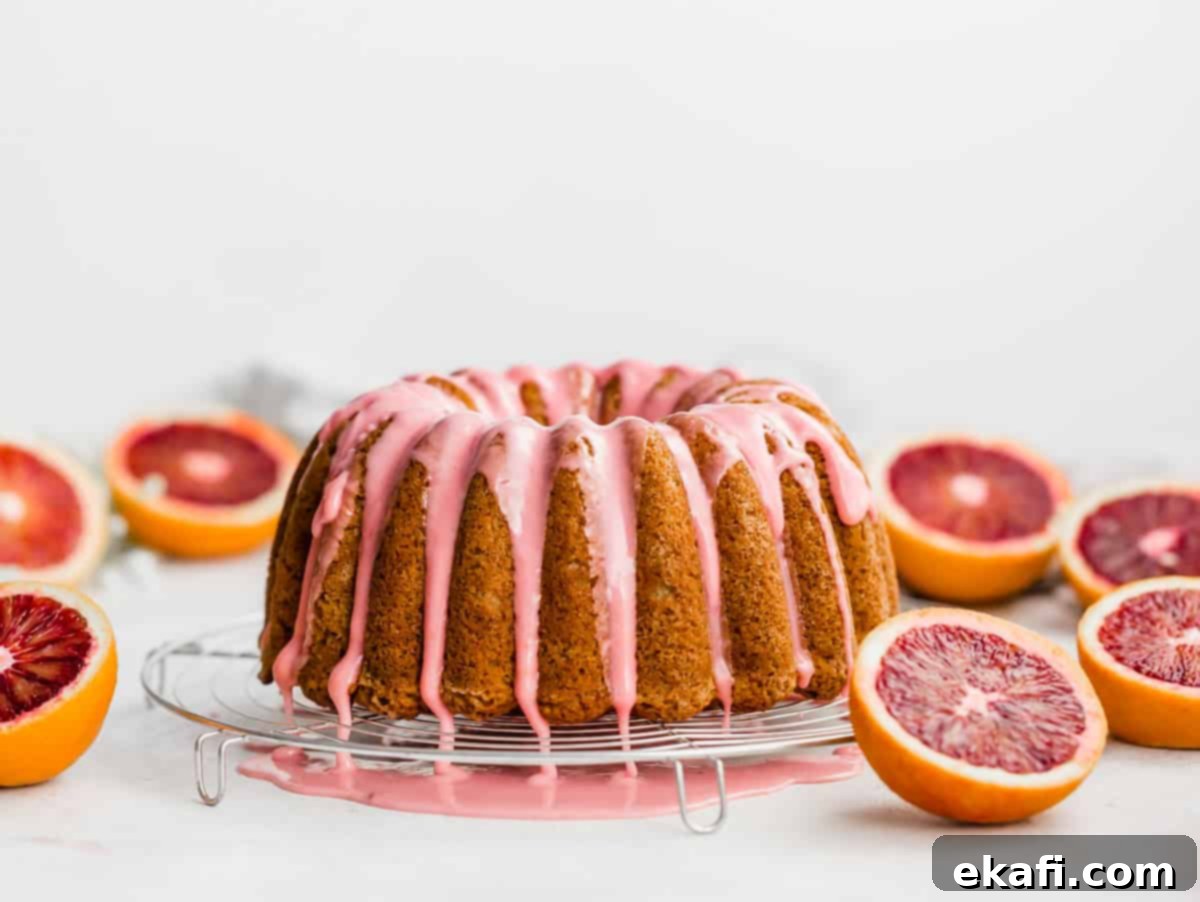
Frequently Asked Questions About Blood Orange Bundt Cake
Blood oranges possess a unique flavor profile that sets them apart from navel or Valencia oranges. While they do have a slight bitterness, similar to that of a grapefruit, it’s often balanced by notes of berry, such as cranberry or raspberry. This complexity is what makes them so appealing in baking and adds depth to our bundt cake.
Blood oranges are typically a winter-to-early-spring fruit. You can usually find them in abundance from December or January through May, with peak season often falling in February and March. Availability can vary slightly depending on your region and climate, so keep an eye out at your local grocery stores and farmer’s markets during these months.
Yes, you absolutely can make a delicious orange cardamom bundt cake using regular oranges! However, keep in mind that you won’t achieve the distinctive deep red or pink color in the cake or the vibrant pink glaze, nor will you get the unique berry-like undertones of blood oranges. Navel oranges are generally the best substitute due to their sweetness and ease of zesting/juicing. Other citrus like grapefruit or lemon could also be used for a different, but equally delightful, flavor profile.
If you don’t have cardamom on hand, the closest substitute for a similar warm, aromatic spice profile would be nutmeg. While it won’t provide the exact same floral notes as cardamom, it will still offer a lovely, comforting flavor. Allspice or a mixed spice blend could also work in a pinch, but be prepared for a slightly different, though still delicious, outcome!
The characteristic deep red, maroon, or even nearly black color of blood oranges comes from pigments called anthocyanins. These are the same natural compounds found in other red, purple, and blue fruits and vegetables like blueberries, raspberries, and red cabbage. The development of anthocyanins in blood oranges is influenced by temperature; they tend to develop their deepest color when the fruits experience cool nights and warm days.
Preventing a bundt cake from sticking is crucial. The key is meticulous preparation of the pan. First, ensure you use a good quality, heavy-duty bundt pan. Second, thoroughly grease every nook and cranny of the pan with softened butter or shortening, using a pastry brush to get into all the details. Third, dust the greased pan generously with flour, rotating and tapping it to ensure the flour coats all surfaces, then tap out any excess. For an extra layer of protection, you can use a non-stick baking spray that contains flour (like Baker’s Joy). Finally, make sure to cool the cake in the pan for 10-15 minutes before inverting it onto a wire rack; this allows the cake to pull away slightly from the sides as it cools, making release easier.
While this recipe is designed for a 10-cup bundt pan, you could adapt it for other cake pans. For instance, you could use two 8-inch round cake pans or one 9×13-inch rectangular pan. The baking time will need to be adjusted significantly; generally, round cakes will bake faster (around 30-35 minutes) and a sheet cake might take 35-45 minutes. Always test for doneness with a toothpick inserted into the center. The beautiful shape of the bundt pan is part of the appeal, but the delicious flavor will translate to any form!
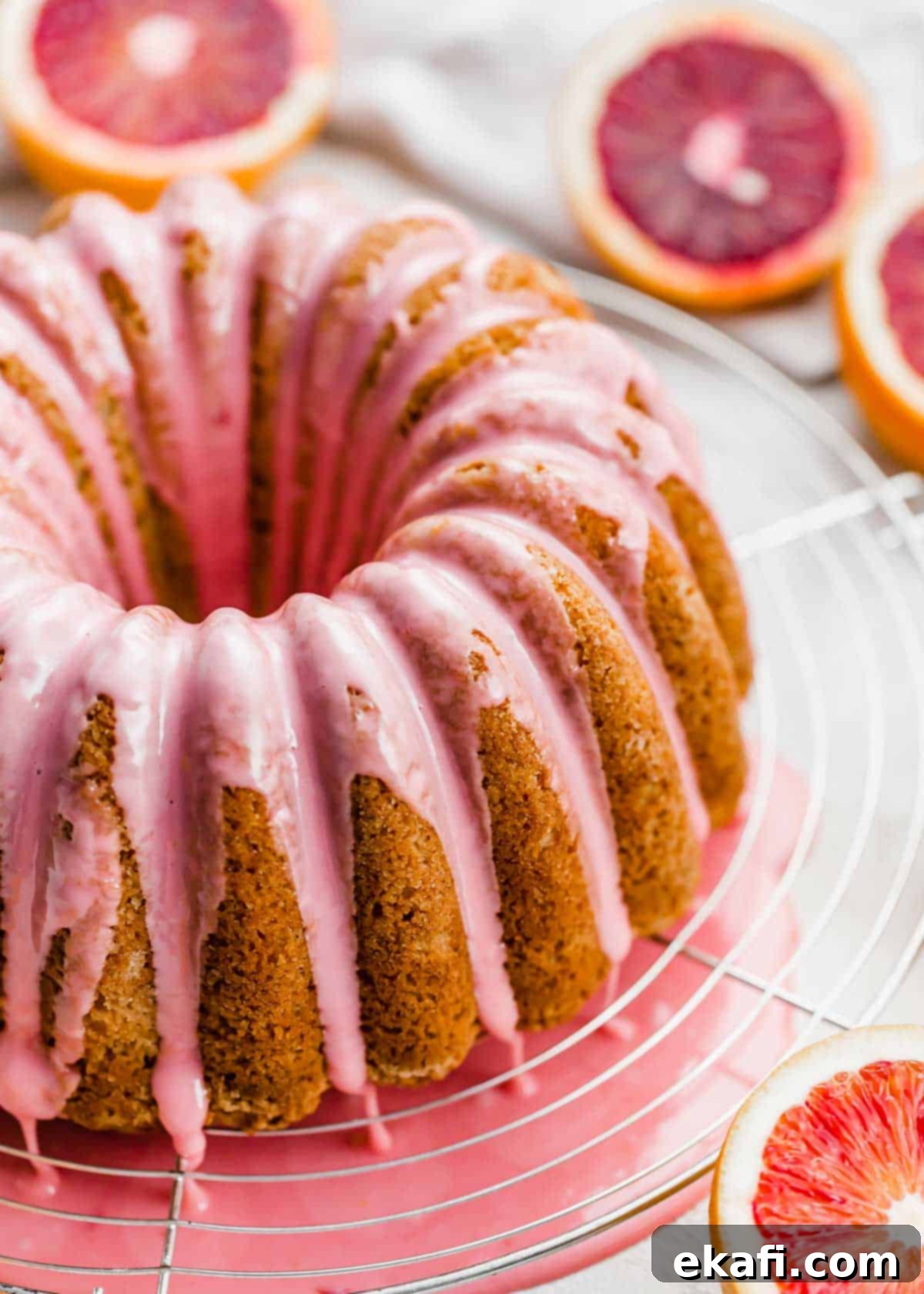
Explore More Delicious Bundt Cake Recipes!
If you’ve fallen in love with the charm and deliciousness of bundt cakes, there’s a whole world of delightful recipes waiting for you. From classic flavors to unique seasonal treats, bundt cakes are perfect for any craving or occasion. Discover more of our favorite bundt cake creations that are sure to become staples in your baking repertoire:
- Lemon Poppy Seed Bundt Cake
- Chocolate Buttermilk Bundt Cake
- Apple Cider Bundt Cake
- Gingerbread Bundt Cake
- Red Velvet Bundt Cake
- White Chocolate Raspberry Bundt Cake
Did you make this incredible Blood Orange Cardamom Bundt Cake? I’d absolutely love to hear about your experience! Leave a star rating and a review right here on the blog post, or scroll down below the recipe card to share your thoughts. Your feedback helps other bakers!
Stay connected and up-to-date with all our latest recipes and baking tips by following us on Instagram, TikTok, YouTube, Facebook, and Pinterest. We love seeing your creations!
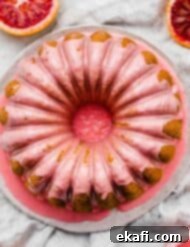
Print
Save
Saved!
Review
Blood Orange Bundt Cake
20 minutes
50 minutes
1 hour
10 minutes
10
slices
Prevent your screen from going dark
Ingredients
Cake
-
3
cups
all purpose flour -
3
teaspoons
baking powder -
3/4
teaspoon
baking soda -
1/2
teaspoon
cardamom -
1/4
teaspoon
cinnamon -
1/2
teaspoon
salt -
1
cup
unsalted butter
– softened -
1
cup
granulated sugar -
1/2
cup
brown sugar – packed -
3
tablespoons
blood orange zest -
1/4
cup
blood orange juice -
3
large
eggs – at room temperature -
1
teaspoon
vanilla extract
-
1
cup
sour cream – I always use full fat
Blood Orange Glaze
-
1/3
cup
blood orange juice – might need more depending on your desired consistency -
1/2
teaspoon
vanilla extract
-
pinch
cardamom -
2 1/2
cups
powdered sugar – might need more depending on your desired consistency
Equipment
-
Kitchen Aid stand mixer
Instructions
Cake
-
Preheat oven to 350°F (175°C). Place the oven rack in the center position of the oven. Thoroughly grease and flour a 10-cup bundt cake pan (see note #1 below for detailed tips). Set aside.
-
In a medium size bowl, whisk together the flour, baking powder, baking soda, cardamom, cinnamon, and salt. Whisk until well combined. Set aside.
-
In the bowl of a stand mixer fitted with the paddle attachment, cream the softened butter, granulated sugar, and packed brown sugar together until the mixture is light in color and fluffy in texture, about 2-3 minutes. Add in the eggs, one at a time, beating well after each addition and scraping down the sides of the bowl as needed. Mix in the blood orange zest, vanilla extract, and blood orange juice until thoroughly combined.
-
With the mixer on low speed, alternate adding the dry flour mixture and the sour cream to the wet ingredients. Begin and end with the flour mixture. The sequence should be: flour, sour cream, flour, sour cream, then finish with flour. Mix only until JUST combined. Be careful not to overmix the batter.
-
Pour the batter evenly into the prepared bundt pan. Bake for 45-50 minutes, or until a toothpick inserted into the center of the cake comes out with only a few moist crumbs attached (mine typically bakes for 47 minutes).
-
Remove the cake from the oven and let it cool in the bundt pan on a wire rack for 10 minutes. After 10 minutes, carefully invert the pan to release the cake onto the wire rack. Allow the cake to cool completely, or until it is just slightly warm to the touch (see note #2 below).
-
Once the cake has cooled sufficiently, drizzle evenly with the prepared blood orange glaze.
Blood Orange Glaze
-
In a small bowl, whisk all of the glaze ingredients (blood orange juice, vanilla extract, pinch of cardamom, and powdered sugar) together until completely smooth. The consistency should be pourable yet thick enough to coat a spoon. If needed, add more powdered sugar (for a thicker glaze) or more blood orange juice (for a thinner glaze) in small increments until your desired consistency is reached.
Notes
- I always ensure my bundt pan is meticulously prepared. This means I first grease it thoroughly with softened butter or shortening, then dust it generously with flour, making sure every crevice is coated. For extra assurance, I follow this by spraying with a baking spray that contains flour (such as Baker’s Joy), which you can find at most grocery stores.
- Once the cake is cool enough to handle but still slightly warm to the touch, I like to cover it tightly with plastic wrap. This helps trap the moisture and prevents the cake from drying out, keeping it wonderfully soft and fresh for longer.
Nutrition
Calories:
618
kcal
(31%)
Carbohydrates:
93
g
(31%)
Protein:
7
g
(14%)
Fat:
25
g
(38%)
Saturated Fat:
15
g
(75%)
Cholesterol:
124
mg
(41%)
Sodium:
249
mg
(10%)
Potassium:
276
mg
(8%)
Fiber:
2
g
(8%)
Sugar:
62
g
(69%)
Vitamin A:
850
IU
(17%)
Vitamin C:
13
mg
(16%)
Calcium:
114
mg
(11%)
Iron:
2
mg
(11%)
Whitney Wright
Dessert
American
Did you make this recipe?
Please leave a star rating and review on the blog post letting me know how you liked this recipe! Take a picture and tag @saltandbaker on Tik Tok, Instagram, and Facebook so I can see what you’re making!
